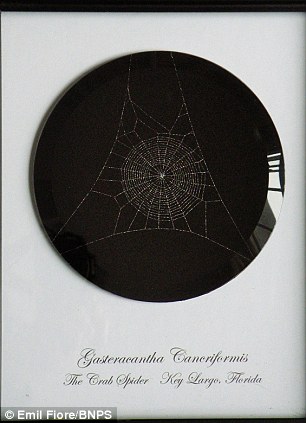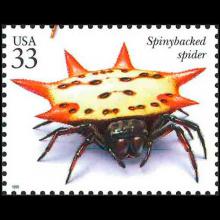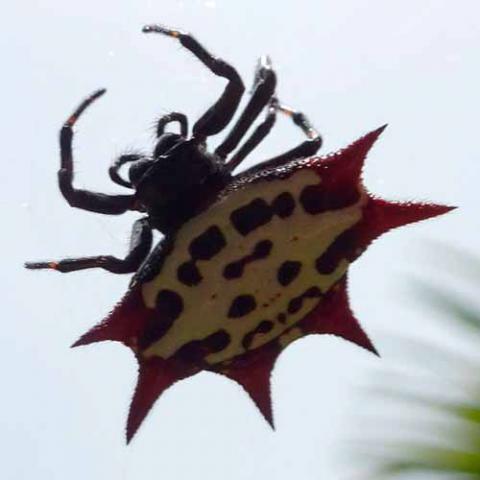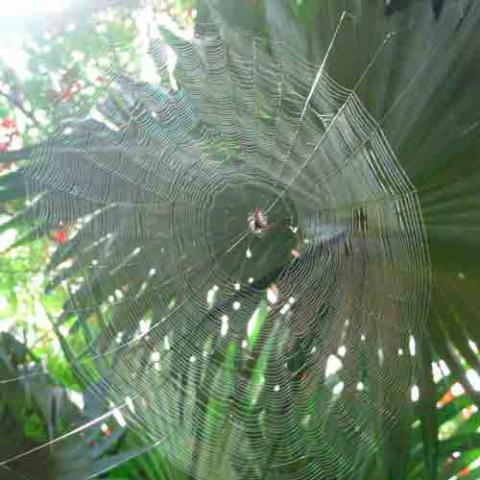NAMES
TAXONOMY
United States
Issued:
Stamp:
Gasteracantha cancriformis
United States
Issued:
Stamp:
Gasteracantha cancriformis
United States
Issued:
Stamp:
Gasteracantha cancriformis
The spectacular Spider-Man: U.S. artist painstakingly captures webbing to create unique pieces of art
15 January 2013
An artist has created stunning designs using spiderwebs he finds on his travels. Emil Fiore, 60, turns the intricate webs into beautiful pieces of art by carefully mounting them on coloured glass which can be displayed on the wall. Each of the New Jersey artist's works are unique and show the differences between spider species and their webs, which can vary between triangular, circular, and hexagonal shapes.
When he finds a delicate web he begins by spraying it with a coloured paint and then places a varnished piece of glass behind it. Once it has stuck firmly in place he coats the back of the glass in a dark colour and waits for it to dry, before selling the works to customers all over the world. The pieces measure between one inch and 30 inches in diameter and sell for up to £180. Emil said: 'I discovered that a local park that I was fond of visiting as a child held a variety of spiders in abundance.

'Spider webs are beautiful and I thought if I could master the catching process, it would be worthwhile. 'I find a nice web, evict the spider, spray the web with paint, spray the glass with varnish, bring the glass to the web and allow the web to bond with the varnish. 'I then wait for it to dry and paint over the varnish with a color that contrasts with the spray paint used on the web. 'At first, I only managed one good catch in 10, now I get about nine out of 10, it is something that I am still learning.'
Talented Emil has become so used to working with spiders he can tell what specific breed has created a web simply by looking at it, and has worked with more than 30 types. These range from the Hyptiotes Cavatus - which produces a triangular shaped web - to the Micrathena Gracilis, which sits in a tightly coiled web. 'Webs are quite recognisable to a trained eye and I have caught over two dozen different species,' he said. 'All spiders weave a web that is unique to the species, some of course are very similar and could be confused with another. 'What I like most is the amazing architecture, beautiful design, perfect irregularity, resilience and strength, and the spiders themselves are awesome looking animals. 'Some, like the triangular web of Hyptiotes Cavatus, are so distinct they would never be confused with another, but I recognise all my webs.'
Genus species (Animalia): Gasteracantha cancriformis
Gasteracantha cancriformis (Spinybacked spider) is a species of orb-weaver spider (family Araneidae). It is widely distributed in the New World.
The genus name Gasteracantha derives from the Greek words γαστήρ (gaster, "belly") and ἄκανθα (acantha, "thorn"), while the specific epithet cancriformis derives from the Latin words cancer ("crab") and forma ("shape, form, appearance").
Females are 5–9 millimeters (0.20–0.35 in) long and 10–13 mm (0.39–0.51 in) wide. The six abdominal spine-like projections on the abdomen are characteristic. The carapace, legs and underside are black with white spots under the abdomen. Variations occur in the color of the upperside of the abdomen: a white or yellow color with both featuring black spots. A white upperside can have either red or black spines while a yellow upperside can only have black ones. Like with many other spiders, males are much smaller (2 to 3 mm long) and longer than wide. They are similar to the females in color but have a gray abdomen with white spots and the spines are reduced to four or five stubby projections.
This species of spider does not live very long. In fact, the lifespan lasts only until reproduction, which usually takes place in the spring following the winter when they hatched. Females die after producing an egg mass, and males die six days after a complete cycle of sperm induction to the female.
Distribution and Habitat
It is found across the southern part of the United States from California to North Carolina, including Alabama as well as in Central America, Jamaica, Cuba, Dominican Republic, Bermuda, Puerto Rico, South America (including south and central Brazil, with several variations according to location) and certain islands in the Bahamas. It has also been sighted in the Whitsunday Islands, Australia, South Africa and Palawan, Philippines, as well as Kauai in the Hawaiian Islands, the Antilles and Koh Chang in Thailand eastern seaboard.
It lives in woodland edges and shrubby gardens. Many of the studies on this spider have taken place in citrus groves in Florida. They frequently live in trees or around trees in shrubs.
Reference: Wikipedia.com
Photos: P. Needle



